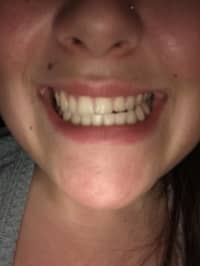A crossbite is a term used to describe malalignment of teeth and can be classified according to its location. An anterior crossbite refers to the upper teeth being behind the lower front teeth, while a buccal or lingual crossbite describes the back teeth where there is a mismatch in its position. A crossbite can be localised to one or 2 pairs of teeth. It can also be generalised involving more than 2 pairs of teeth. It can be unilateral or bilateral, meaning on one side only or happening on both sides.
The presentation of the crossbite gives me a clue on whether the cause of the crossbite is just malalignment of the teeth or its related to a malalignment of the jawbones housing the teeth. Generally speaking, if the crossbite is localised and unilateral, it is confined to malalignment of the teeth and can be corrected with repositioning the teeth in crossbite.
This can, of course, be achieved with braces or aligner treatment. Alternatively, though this is not something I would recommend, it may be possible to change the orientation of the crowns of the teeth by repositioning the crowns prosthodontically. This involves cutting the teeth involved in the crossbite correction to a small stump and placing an artificial crown in a different orientation to mask its previous position. However this may not be possible for all crossbite correction and is also quite destructive if the teeth are intact, it is best to check with your dentist.
If the crossbite is bilateral and generalised, it is likely related to the jawbones housing the teeth. A buccal crossbite that is bilateral may suggest a narrow upper jaw or a wide lower jaw. The correction will have to be done orthodontically through an expander or other orthodontic means.
Lastly, if the crossbite is unilateral and involves both the front teeth and the back teeth, it is quite likely that it is related to the jawbones housing the teeth which seems to be the case from the photo you have submitted. It appears to me that you have a lower jaw that is shifted to the left side resulting in a crossbite on the left side.
Correcting a crossbite related to the jawbones housing the teeth will require repositioning the cause of the problem (i.e repositioning the lower jaw), this involves braces treatment together with orthognathic surgery. Do speak to your dentist/orthodontist about what are your treatment goals and he/she will be able to inform you of your options.



